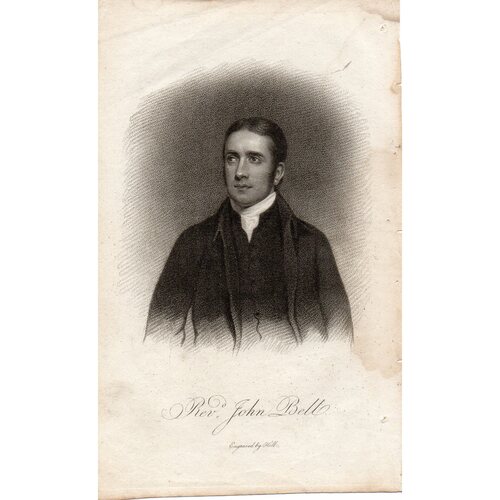BELL, JOHN, Wesleyan minister; b. 19 Oct. 1788 in Kingston upon Hull, England, son of Robert and Sarah Bell; m. Mary Ann ——; d. 26 Oct. 1855 in England.
The son of Episcopalians, John Bell was confirmed a Methodist at age 14. He was received as a local preacher in 1809, was ordained two years later, and then travelled for five years on the home circuit. In 1816 he was the senior of six missionaries dispatched to Newfoundland by the British Wesleyan Conference. With two of these men, George Cubit* and Richard Knight, he left Poole, Dorset, on 1 August, arriving at Carbonear on 4 September. The Newfoundland mission had been part of the Nova Scotia District since 1787, but in 1815 it was constituted a separate district and William Ellis* was named the first chairman. Bell had been designated Ellis’s successor by “his English brethren” and assumed the post on his arrival. Affectionately known as “the Bishop,” Bell retained the chairmanship until he returned to England in 1823. While in Newfoundland, he first served in the circuit of Lower Island Cove and Perlican, then in St John’s, Harbour Grace, and Port de Grave.
With the arrival of the missionaries in 1816, the Newfoundland District increased its circuits from five to eleven, spread along the coast from Bonavista in the northeast to Grand Bank in the south, with the main concentration in the Conception Bay area. At this time there were approximately 500 adherents on the island. As well as the Methodists, there were seven Roman Catholic priests, three Church of England clergymen, and one Congregational minister in Newfoundland, most of whom were “settled” in and around St John’s. Only the Wesleyans braved the natural dangers of all seasons and faced “wild beasts and wilder men” to cover vast areas four and five times annually. Bell reported at his first district meeting on 3 June 1817 that during the past year he had visited all the circuits except Burin and Grand Bank.
From 1816 to 1818 Newfoundland suffered from a serious economic depression which had followed several years of buoyancy as a result of the Napoleonic Wars. The economic disruption caused by the fires of 1816, 1817, and 1818 in St John’s, as well as the poor returns from the cod and seal-fisheries, and the loss of markets, had forced many church members out of the city in order to find work. The beginning of a renewed prosperity came in 1818, the year Bell replaced Cubit in St John’s, but Bell’s newly acquired congregation had been scattered and those who remained were saddled with an intolerable debt. Under Bell’s strong leadership, and with the assistance of the British conference, the debt was nearly liquidated by mid 1819 and Bell was spearheading a drive for funds to construct a parsonage; known as the Wesleyan Mission House, it would thereafter serve as a focal point for Methodism on the island. On a visit to England in March 1820 Bell raised an additional £350 for the Newfoundland District but was unsuccessful in an attempt to persuade his colleagues to appoint an assistant to the St John’s circuit so that the Methodists in the adjacent coves could also receive the ministrations of a clergyman.
Bell was a very neat and precise person, an excellent pastor and administrator. Although not a great preacher, he delivered his sermons simply and powerfully. However, he might have had some assistance in writing them. According to the historian Philip Tocque*, “Mr Cubit sold Bell 30 or 40 of his MS sermons which was the making of Bell as a preacher.” After seven fruitful years in Newfoundland, Bell returned to England in 1823 where he served in several pastorates over the next 28 years. Growing infirmities obliged him to accept a supernumerary retirement in 1851. He died peacefully four years later in the 45th year of his ministry, survived by his wife who passed away the following year.
Holy Trinity Parish Church (Church of England) (Hull, Eng.), Reg. of baptisms, 3 (1689–1792): 152. Wesleyan-Methodist Magazine (London), 39 (1816): 954–55; 42 (1819): 75–76; 79 (1856): 843–44. Newfoundland Mercantile Journal, 25 March, 11 Nov. 1819; 4 April 1822. When was that? (Mosdell), 9. A century of Methodism in St. John’s, Newfoundland, 1815–1915, ed. J. W. Nichols (n.p., [1915]), 29. G. G. Findlay and W. W. Holdsworth, The history of the Wesleyan Methodist Missionary Society (5v., London, 1921–24), 1: 273–76. D. G. Pitt, Windows of agates; a short history of the founding and early years of Gower Street Methodist (now United) Church in St. John’s, Newfoundland (St John’s, 1966), 41–44. T. W. Smith, Hist. of Methodist Church, 2: 35–40. William Wilson, Newfoundland and its missionaries . . . to which is added a chronological table of all the important events that have occurred on the island (Cambridge, Mass., and Halifax, 1866), 234–37. Daily News (St John’s), 26 March 1960.
Cite This Article
Calvin D. Evans, “BELL, JOHN (1788-1855),” in Dictionary of Canadian Biography, vol. 8, University of Toronto/Université Laval, 2003–, accessed December 5, 2025, https://www.biographi.ca/en/bio/bell_john_1788_1855_8E.html.
The citation above shows the format for footnotes and endnotes according to the Chicago manual of style (16th edition). Information to be used in other citation formats:
| Permalink: | https://www.biographi.ca/en/bio/bell_john_1788_1855_8E.html |
| Author of Article: | Calvin D. Evans |
| Title of Article: | BELL, JOHN (1788-1855) |
| Publication Name: | Dictionary of Canadian Biography, vol. 8 |
| Publisher: | University of Toronto/Université Laval |
| Year of publication: | 1985 |
| Year of revision: | 1985 |
| Access Date: | December 5, 2025 |



